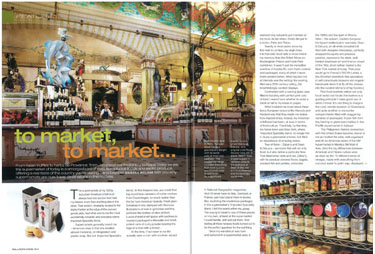From Italian truffles to herbs de Provence, from Japanese confectionery to Napa Valley wines, the supermarket of today is a smorgasbord of vivid, sumptuous foods and exotic produce, offering a real taste of the country you're visiting - and beyond. DAISANN MCLANE tells you why supermarkets are now travel destinations in themselves.
The supermarkets of my 1970s suburban American childhood always had one section that held my interest more than anything else in the store. That section, invariably located in the dusty frontier at the edge of the canned good aisle, had what was to me the most wonderfully romantic and evocative name: Imported Speciality Items.


|

Supermarkets generally bored me American ones in that era smelled almost medicinal, of refrigeration and plastic wrap. But not 'Imported Speciality Items'. In this treasure box, you could find big round blue canisters of butter cookies from Copenhagen, so much tastier than the ho-hum American brands. Fresh plum tomatoes in tins stamped with Baroque illustrations of men in gondolas and tiny, perfume-likes bottles of olive oil from Lucca shared shelf space with sardines in mustard packaged in Marseille and small, potent cans of curry powder bearing the logo of a man with a turban.
At the time, I had never in my life actually seen a man with a turban, except in National Geographic magazines. And I'd never been to Italy, Denmark or France, just read about them in books. But, exploring the mysterious packages in the supermarket's 'Imported Speciality Items' I felt the world within my grasp. Too young to travel to any of these places on my own, at least at the supermarket I could handle, sniff and eat them. And tasting all these faraway foods turned out to be the perfect appetiser for the real thing.
|
|
 Since my wanderlust was born and nurtured in a supermarket aisle, It seemed only natural to put markets on my must-do list when I finally did get to London, Paris and Tokyo. Since my wanderlust was born and nurtured in a supermarket aisle, It seemed only natural to put markets on my must-do list when I finally did get to London, Paris and Tokyo.
Twenty or more years since my first visit to London, my virgin foray into Harrods' food halls is more vivid in my memory than the British Museum, Buckingham Palace and Hyde Park combined. It wasn't just the incredible overflow of foodstuffs, both fresh-cooked and packaged, many of which I never knew existed before. What dazzled me at Harrods was the setting: the soaring, tiled early 20th-century ceiling, the breathtaking curated displays.
Confronted with a curving glass case filled to bursting with perfect pink cuts of beef, I wasn't sure whether to order a steak or fall my knees in prayer.
What troubled me most about these fancy European emporia like Harrods and Hediard was that they made me realise how impoverished, indeed, my American childhood had been, at least in terms of food culture. Thankfully, by this time, my home town was New York, where 'Imported Speciality Items' no longer hid in dusty supermarket shelves, but filled an abundance of amazing stores.
Two of them - Zabar's and Dean & DeLuca - are icons that sell not only food, but also define a particular New York Manhattan style and era. Zebar's, with its sawdust-covered floors, bagels, smoked fish and pickle embodies the 1980s and the spirit of Woody Allen - the uptown, Eastern European immigrant intellectual or wannabe. Dean & DeLuca, an all-white industrial loft filled with designer chocolates, perfectly wrapped bouquets and precious pastries, represents the sleek, well heeled downtown art and finance crowd of the '90s. (And neither market is the New York market of today. That prize would go to Franny's BKLYN Larder, a tiny Brooklyn storefront that specialises in self-consciously locavore and organic handmade items that fly off the shelves into the curated kitchens of hip foodies.)
That food markets reflect not only local tastes but locals themselves is a guiding principle I make good use of when I travel. It's one thing to imagine the cold, remote isolation of Greenland, and quite another to encounter compartments filled with staggering varieties of packaged, frozen fish from tiny herring to giant-sized halibut in the Pisiffik supermarket in llusissat.
The Philippines' historic connection with the United States became clearer to me as I trolled the wide, well-organised and oh-so American aisles of the SM hypermarket in Manila's SM Mall of Asia. (And the big differences between American and Filipino culture were as clear as the 15 different kinds of vinegar, made with everything from coconut water to palm sap, displayed on that market's shelf).
And what better gauge of Japan's modernity and sophistication than the basement of Isetan department store in Tokyo, where a single shopping trip can score you a container of miso (fermented soya bean) paste from a small village in Shikoku and croissants flown in fresh from Paris that day?
In Hong Kong, where I live now, I shop at outdoor wet markets, with occasional forays into our local grocery store chain, Parknshop, for household staples: toilet paper, gallons of bottled water, cheap Australian wine for parties. But for special-occasion supermarket shopping. I head for City'super, a breathtakingly well-stocked luxury market that caters to the tastes of Hong Kong's muti-cultural Asian and expat high rollers this is probably the only place in town where you can fill your cart, in one trip, with handmade Kyoto rice crackers, Canadian organic beef and Spanish jamon lberico (lberico cured ham).
At City'super, every item, from the humblest bulb of garlic to the US$250 box of fresh sea urchins, is labelled with the flag of the country it comes from (and also, usually, with the words: Flown in fresh todays!). Strolling through the aisles of City'super I don't feel like I'm shopping - I feel like I'm meandering in an international airport where the vegetables all have passports. For a supermarket traveller who launched her love for all things foreign among dusty cans of curry powder, it's a dream come true.
Super supermarkets around the world
Lifestyles are changing - and supermarkets along with them. Both sensory experience and entertainment, the modern market puts as much thought into presentation and design as it does the variety and quality of food. Today's global shopper wants to be fully engaged, and fully gratified, and these supermarkets, recognised by design and trade magazines and organisations, offer theatrical settings - from props to dramatic lighting - that set the stage for stars from halfway across the globe, located just down the next aisle. Store design guru MARTIN PEGLER picks his favourites:
Ole', Shenzhen, China
Located in Holiday Plaza Shopping Center, a mixed-use, upscale development of hotel suites, offices and shops in Shenzhen, this supermarket designed by Bangkok's rkd retail/iQ offers Chinese and Western imported gourmet and new to market foods and drinks for high-end shoppers who live nearby.
Dropped ceilings and dramatic lighting add to the drama of the space, and the finishing materials and details are polished and refined. What's on offer goes way beyond rice and noodles - you'll find speciality snacks, health foods, imported cheeses and meats, plus an entire area devoted to fine wines and liquors from all over the world. Shellfish, from local waters and farther afield like the Pacific Islands and Alaska, are artistically arranged amid lemons, limes and green leaves, all floating on beds of ice. From the bakery, the heady aroma of hot-from-the-oven, beautifully displayed local and Western breads and pastries fills the air.
The supermarket has been further enhanced with a demonstration kitchen where regular cooking events are held, featuring fresh foods and various culinary equipment, so shoppers can sample the produce, as they attempt to absorb everything around them.
John Lewis Foodhall from Waitrose, London, UK
For an idea of the temperament and tastes of today's Londoner, head to John Lewis, a seven-storey department store (voted Britain's favourite store) located on busy thoroughfare Oxford Street. John Lewis' 1,580 sqm basement Foodhall from Waitrose was designed by London-based consultancy JHP, which described how the store's suite of communications made the retailer's focus on ethically sourced produce immediately apparent to the shopper. The warm and unpretentious interior was designed for show not showing off so while you'll find seasonally sourced speciality foods, it's solid British comfort food that takes centre stage, including over 100 varieties of the finest local and regional cheeses (tasting sessions are available), and dedicated meat and charcuterie counters offering succulent, premium cuts such as free-range Berkshire pork, dry-ages Aberdeen Angus beef and hand-carved Iberico ham.
Feature
Adding to the wholesome feel is a mix of natural wood fixtures, counters, and tables with wicker baskets containing freshly baked breads and pastries, and produce delivered straight from local suppliers. The cool white walls are adorned with custom black and white photographs that help to identify the separate areas in the market. For a takeaway lunch, choose from fresh salads, warming soups and flavoursome baguettes. To cool down in summer, try one of their smooties. www.johnlewis.com/oxfordstreet
Casino Supermarche, Paris, France
In the Menilmontant neighbourhood of Paris, the designers Saquez & Partners created a fresh and invigorating universe: the small, dark crowded store that was previously Casino Supermarche was opened up to allow daylight in, and the palette was reworked in refreshing yellows and greens. The store's lighting plan is now more energy-efficient and accentuates the food displays - fresh fruit and vegetables are arranged by colour, and bask in a warm, beigey ambience. The use of wood and stainless steel trim in shelves throughout the store recalls French kitchen appliances and imbues it with a home-like quality, while colourful graphics and giant photo blow-ups add a dash of fun to the setting. The extra attention paid to the selection and layout of the wine department arranged by vineyard and country, plus there's a sommelier around should you need help - endears it to the French shopper.
Bravo Supermercado, Santo Domingo, Dominican Republic
When Nick Giammarco of GHA Design Studios was asked to design Bravo Supermercardo, the objective was to create 'a European hypermarket look with strong local flavour'. More specifically to introduce the look, feel and size of a modern hypermarket, while also bearing in mind the value-conscious shopper. The store is located in busy urban spot Avenida Winston Churchill, and is designed along crisp, clean lines with strong energetic colours of reds, greens and oranges echoes of Latin America art appearing both outside and inside the store. Graphics in these same colours, awnings over special sections for easy identification, and careful thought to details such as the integration of lighting and signs at checkout counters add texture to the space, while highlighting the produce on display. As tastes evolve, a demonstration kitchen is being installed, where cooking classes will be held. In the meantime, tasting programmes are being run, often with professional chefs offering food samples.
|